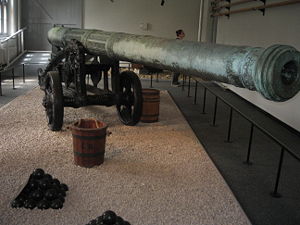.gif)
Basilisk (cannon)
Encyclopedia

Bronze
Bronze is a metal alloy consisting primarily of copper, usually with tin as the main additive. It is hard and brittle, and it was particularly significant in antiquity, so much so that the Bronze Age was named after the metal...
cannon
Cannon
A cannon is any piece of artillery that uses gunpowder or other usually explosive-based propellents to launch a projectile. Cannon vary in caliber, range, mobility, rate of fire, angle of fire, and firepower; different forms of cannon combine and balance these attributes in varying degrees,...
employed during the Middle Ages
Middle Ages
The Middle Ages is a periodization of European history from the 5th century to the 15th century. The Middle Ages follows the fall of the Western Roman Empire in 476 and precedes the Early Modern Era. It is the middle period of a three-period division of Western history: Classic, Medieval and Modern...
. The barrel of a basilisk could weigh up to 4,000 lb (1,800 kg) and could have a calibre of up to 5 inches (13 cm). On average they were around 10 feet long, though some, like Queen Elizabeth's Pocket Pistol
Queen Elizabeth's Pocket Pistol
Queen Elizabeth's Pocket Pistol is a cannon built in 1544 in Utrecht by Jan Tolhuys, before Elizabeth came to the throne. The gun was presented to Henry VIII by Maximiliaan van Egmond, Count of Buren and Stadtholder of Friesland as a gift for his young daughter Elizabeth.The cannon measures 24ft in...
, were almost three times that length.
The basilisk got its name from the mythological basilisk
Basilisk
In European bestiaries and legends, a basilisk is a legendary reptile reputed to be king of serpents and said to have the power to cause death with a single glance...
: a fire-breathing venomous serpent that could cause large-scale destruction and kill its victims with its glance alone. It was thought that the very sight of its 160 lb shot would be enough to scare the enemy to death.
In 1588 the Spanish Armada
Spanish Armada
This article refers to the Battle of Gravelines, for the modern navy of Spain, see Spanish NavyThe Spanish Armada was the Spanish fleet that sailed against England under the command of the Duke of Medina Sidonia in 1588, with the intention of overthrowing Elizabeth I of England to stop English...
was equipped with many basilisks for their invasion of England with the intent of using them to besiege towns loyal to Elizabeth I
Elizabeth I of England
Elizabeth I was queen regnant of England and Ireland from 17 November 1558 until her death. Sometimes called The Virgin Queen, Gloriana, or Good Queen Bess, Elizabeth was the fifth and last monarch of the Tudor dynasty...
. Many of these guns were lost when the ships were wrecked on their return to Spain.
Due to its large size, the basilisk fell out of favour of European generals, who preferred lighter, more accurate artillery in the late 16th century. A late example is the Maltese Gun, built in Holland in 1607 and, like many of its contemporaries, was fitted with a replacement carriage during the Napoleonic Wars
Napoleonic Wars
The Napoleonic Wars were a series of wars declared against Napoleon's French Empire by opposing coalitions that ran from 1803 to 1815. As a continuation of the wars sparked by the French Revolution of 1789, they revolutionised European armies and played out on an unprecedented scale, mainly due to...
.

